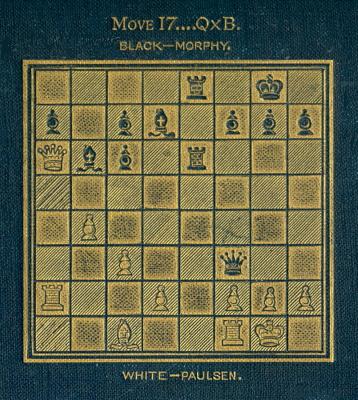
Edward Winter

Front cover of The Modern Chess Instructor by W. Steinitz
As is well known, though not always mentioned by annotators, in his famous win against Louis Paulsen at New York, 1857 Morphy overlooked quicker mates at moves 22 (...Rg2), 23 (...Be4+) and 24 (...Bg2+). The second and third of these are, of course, the same mating line.
It is worth recalling the discussion in such popular books as Chernev’s The Bright Side of Chess (pages 120-122) and The Chess Companion (pages 231-233). In the latter work the discovery of 22...Rg2 was credited to Zukertort, and it was stated that 23...Be4+ was ‘pointed out by Bauer’. Many other books say the same. On the other hand, page 71 of Morphy Chess Masterpieces by F. Reinfeld and A. Soltis (New York, 1974) referred to 22...Rg2 as ‘the beautiful four-move win discovered by Steinitz’. (The annotations were by Reinfeld, having previously appeared on page 327 of the November 1954 Chess Review.)
So, was it Zukertort or Steinitz who first pointed out 22...Rg2, and where exactly did Bauer comment on the game?
On pages 171-173 of the February 1887 Chess Monthly an article by Zukertort was published under the title ‘The Morphy-Paulsen End-Game’:
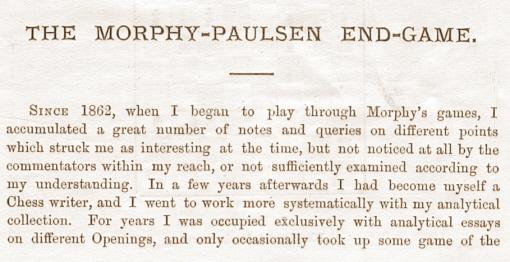
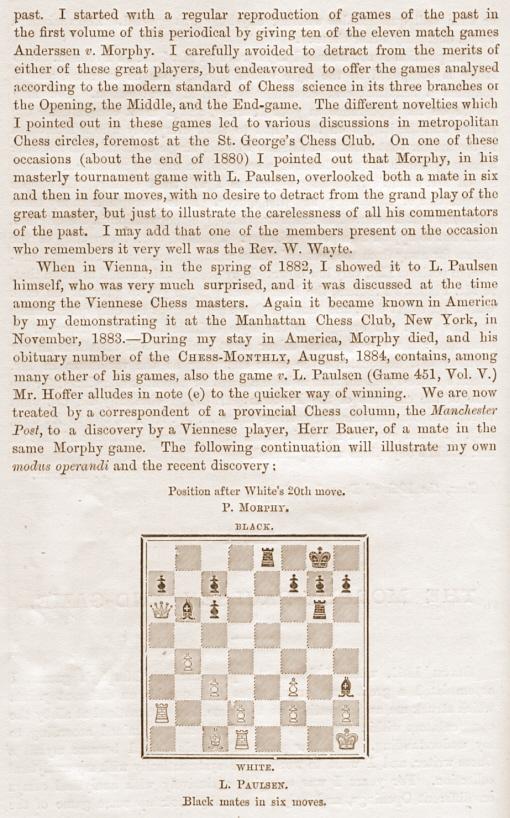
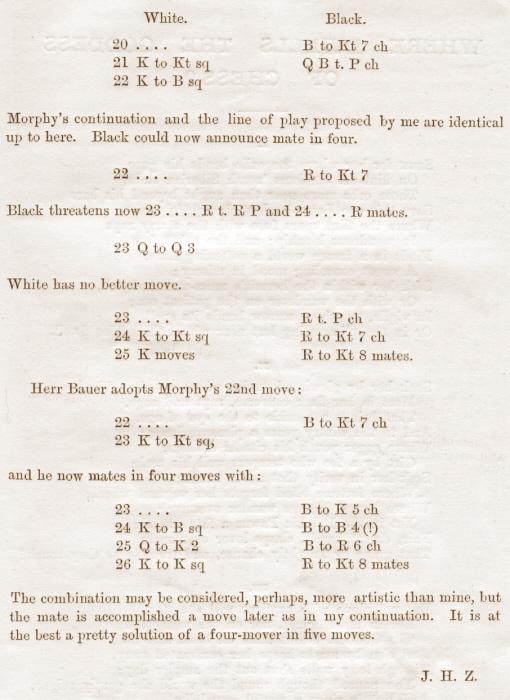
Steinitz, for his part, gave the game on pages 48 and 51 of part one of The Modern Chess Instructor (New York, 1889). Without offering details he asserted that it was he who had ‘first discovered’ 22...Rg2 (‘though it was afterward claimed by another player now deceased’). Steinitz made no mention of Bauer’s 23...Be4+:

What was the exact chronology of the analytical findings by Steinitz, Zukertort and Bauer in the Paulsen v Morphy game?
(7120)
After giving the finish of Morphy’s celebrated win at New York, 1857 against Louis Paulsen (17...Qxf3), Fred Reinfeld wrote on page 156 of Great Moments in Chess (New York, 1963):
‘Beautiful, isn’t it? Géza Maróczy, the author of a definitive book of Morphy’s games, has this closing comment: “Morphy played the whole game faultlessly, powerfully, and with youthful verve.”Is this the truth, the whole truth, and nothing but the truth? Not by a long shot.’
Reinfeld then discussed the play from move 17 onwards, examining the quicker wins missed by Morphy.
Contrary to the impression thereby created, such improvements had
also been reported in Maróczy’s book Paul Morphy (Leipzig,
1909 and Berlin and Leipzig, 1925), on pages 45-46 and 30-31
respectively. See too pages 30-31 of the English-language edition
by Robert Sherwood (Yorklyn, 2012).
It is curious that despite analysing Morphy’s inferior handling of the conclusion, Maróczy did indeed write that Morphy had played the game faultlessly, as quoted by Reinfeld above. Both editions of Maróczy’s book stated:
‘Morphy spielte die ganze Partie tadellos, durchwegs kräftig und mit jugendlicher Verve.’
Conscientious annotators naturally mention the faster wins missed by Morphy in the Paulsen game. On pages 24-26 of Duels of the Mind (London, 1991) Raymond Keene noted none of them.
(10029)
C.N. 10689 showed the first page of unit three of Amenities and Background of Chess-Play by W.E. Napier (New York, 1935), where the Paulsen v Morphy brilliance was described as ‘an off-hand game’:
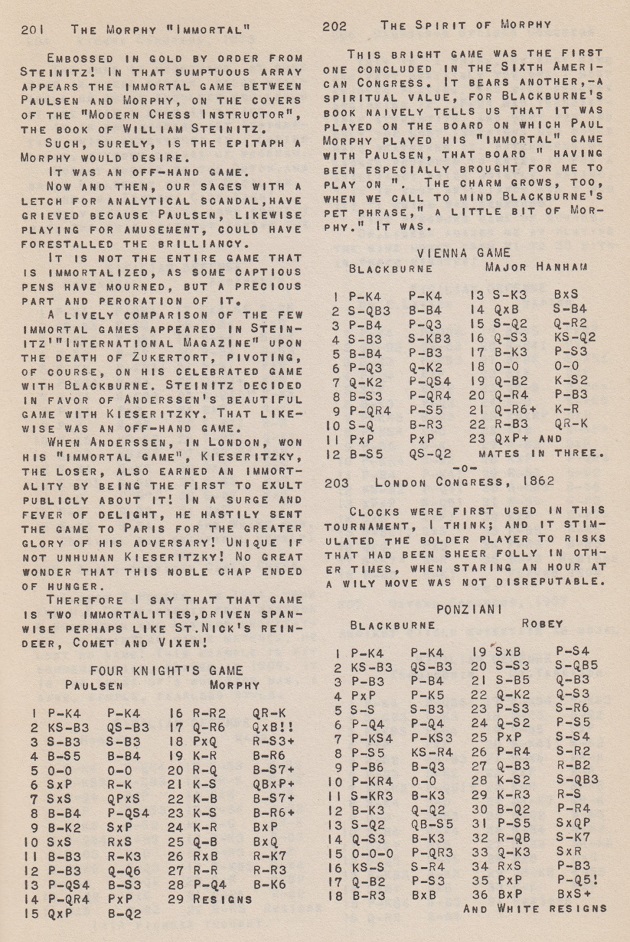
In the final round of the New York, 1857 tournament, Morphy defeated Louis Paulsen +5 –1 =2. According to the Lange, Maróczy and Sergeant monographs on Morphy, the dates of the eight games were as follows: First: 29 October; Second: 30 October; Third: 2 November; Fourth: 4 November; Fifth: 6 November; Sixth: 8 November; Seventh: 8 November; Eighth: 10 November.
Hans Renette (Bierbeek, Belgium) writes:
‘My particular interest is in the dates of the concluding games between Morphy and Paulsen. The New York, 1857 tournament book is rather vague and not altogether trustworthy. On page 68 of Paul Morphy The Pride and Sorrow of Chess (New York, 1976) David Lawson stated that the sixth game was played on 3 November, and page 71 gave 6 November and 10 November as the respective dates of the seventh and eighth games. There was no explanation for the gaps in the schedule.
The New Orleans Daily Picayune of 13 November contains a quote from the New York Courier and Enquirer of 6 November which reported that the final game had been played on 5 November:
‘The chess congress was virtually brought to a close last evening by Paul Morphy winning the decisive game, the fifth, from Mr Paulsen [the eighth game is meant, i.e. Morphy’s fifth victory – H.R.]. Mr Paulsen was suffering from a severe catarrh yesterday, and might with great propriety have requested a postponement of the contest; but he fought gallantly and yielded gracefully.”
The New York Times reported on 7 November:
“At the chess congress Mr Morphy has won five games in the last section of the Grand Tournay, entitling him to the first prize.”
Which newspapers of the time allow the games to be dated precisely, beyond all doubt?’
(10754)
The Paulsen v Morphy game was annotated on pages 85-86 of Emanuel Lasker’s London Chess Fortnightly, 14 January 1893. The forced mate overlooked at move 22 was mentioned.
John Hilbert (Amherst, NY, USA) draws our attention to an article about Morphy and Paulsen published in the Anglo-African Magazine for September 1859 and reprinted in the National Era, 29 September 1859. Our correspondent remarks that it was ‘by James M’Cune (McCune) Smith, who I believe was a Black journalist before the American Civil War. The piece describes in some detail his witnessing Morphy and Paulsen playing a game at New York, 1857’.
From the lengthy article (approximately 3,700 words) we quote the descriptive passages regarding Morphy and Paulsen:
‘Having seen their portraits in Frank Leslie, we instantly singled out Paulsen and his great antagonist, and a little skillful elbowing found us seated beside their board. There was Louis Paulsen, with his vast head, sanguine temperament, but coarse fibre, indicating his rough, almost pure-Bersekir blood; and as we gazed at Morphy, with his fine, open countenance, brunette hue, marvellous delicacy of fibre, bright, clear eyes, and elongated submaxillary bone, a keen suspicion entered our ethnological department that we were not the only Carthaginian in the room. It might only be one drop, perhaps two, God only knows how they got there, but surely, beside the Tria mulattin who at present writes, there was also a Hekata-mulattin in that room.
It was the old combat between Coeur de Lion and the Saladin. How strange that the Orient and the Occident should yet war. Paulsen huge, massive, ponderous; Morphy slight, elegant, yet swift as lightning.
The game was about half through, so far as the number of moves were concerned. Paulsen hesitated, clasped his hands, leaving out the two long fore-fingers, which he laid firmly on the edge of the board, counted over the five or six possible moves of his opponent, and then evidently knew something more would follow, but what? You could almost see him think; at length, with a peculiar flourish of his arm, he seizes a pawn, and moves. With scarcely a moment’s hesitation, with his eyes for an instant bent on the board, Morphy raises his arm as if to strike, and throws a piece right in the way of his antagonist. Another long, long pause, the hands again clasped: “why, take the piece, man”, is on everybody’s unopened lips; yet Paulsen pauses, again clasps his hands, and for nearly half an hour pores over the board; he does not take the proffered piece, but offers one of equal value; then something akin to electricity flashed through and out of Morphy, the calm white forehead “pleated up”, his arm raised, he swiftly moves; and, as if caught with the same impulse, Paulsen moves instantly; then, for a few seconds, there is a click, click, click, a move each second, percussion-caps, rifles, cannons, grape, canister, the clash of swords and then all is still. Flushed with the struggle, Paulsen looks up to see why the other sits calm and cold as an icicle; Paulsen glances again at the board, and sees mate for himself three or four moves off.
… The moment that Morphy completed a move, he threw the whole board away from his attention, brushed away magnetism, so to speak, often went off to the other end of the room, and had to be summoned thence to reply to Paulsen’s move.
… In looking at Morphy and Paulsen, in 1857, we were struck with the evident purity of both these young men. Neither presented the bleared eyes, shaking hands, nor nervous tremor which a four-hours sitting would betray in nine-tenths of our young men of the city; they were plainly in perfect physical condition, and all their faculties were clear and in full honest exercise. And so must the devotees of chess keep themselves, or they will inevitably lose rank as chessplayers.’
(3339)
See too Paul Morphy, Chess and Time and World Champion Combinations.
To the Chess Notes main page.
To the Archives for other feature articles.
Copyright: Edward Winter. All rights reserved.